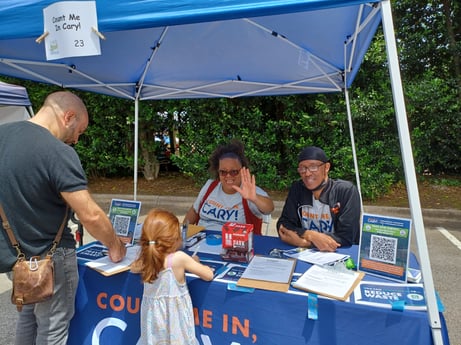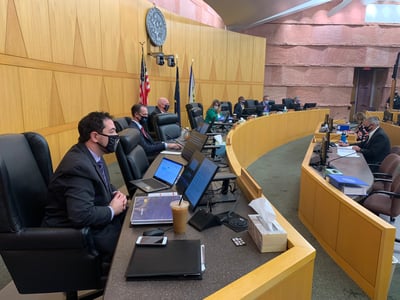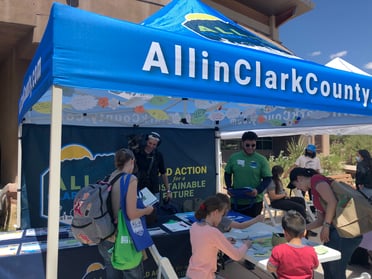
Climate ambassadors in Cary, NC spread the word about the Count Me in, Cary! climate action strategy
You might not be surprised to learn that trust in federal elected officials is in the basement. Only about 32% of Americans have a “great deal/fair amount of trust” in Congress – 23% have “none at all”. Top billing for trust among government institutions is local governments with 67% (though even that number has dropped from 75% just a few years ago).

Source: Gallup
Perhaps that reflects your own opinions or rings true with what you see in the headlines. It’s one of the many reasons why KLA focuses almost exclusively on local governments. But our laser focus on US cities, towns and counties is rooted more in the positives than the negatives: they are perfectly positioned and extremely motivated to meet the urgency of the climate crisis. Not through municipal operations alone but by sparking and enabling behavior change in the community.
Much has already been written about the importance of local governments in advancing critical climate action, so we’ll hit the highlights here (not in ranked order):
Laboratories for Change
Local governments have historically been laboratories for change. That’s where innovative ideas take root in response to challenges and opportunities – where community leaders are willing and able to give something a shot. Even when they blossom at the state or federal level, the seeds of change are often planted at the local level. Affordable housing, gay marriage, minimum wage and – near and dear to our heart – climate change.
In many cases, the absence of state or federal action or conflicting or controversial policies has elevated the role of local governments. Local climate action – in the form of pledges, ordinances, plans – spiked when Presidents George W. Bush and Trump weakened or rescinded federal climate protection policies.
Domino Effect
While the gears of government grind slowly in state houses and the US Capitol, local governments can move much faster and, cumulatively, have a significant impact. The local level is the ideal space to pilot new initiatives and solutions and then bring to scale. Through entities like the Urban Sustainability Directors Network (USDN), National League of Cities (NLC), National Association of Counties (NACo) and other networks, local governments of all shapes and sizes can share the best practices and troubleshoot effective strategies to really move the needle together. Indeed, our CEO just returned from the USDN conference in New Orleans (which KLA was proud to sponsor) completely energized and inspired by those connections and the power of that collective body.
Bridging the Partisan Divide
It’s much easier to put aside political affiliations and reach consensus at the local level. Hence, the higher levels of trust for local elected officials. These are people who have to answer – in regular, face-to-face meetings – for their actions or lack thereof. Local leaders don’t have the luxury of hiding in Washington, D.C. They have to be there to answer questions directly from their constituents and to deal with the impacts of climate change. When streets and neighborhoods flood due to extreme weather events or water has to be rationed to deal with severe drought, it is the mayors and county executives and other local leaders that must keep their communities safe.

Clark County Board of Commissioners meeting during the All In Clark County planning process
City, county and town governments can also tailor their messaging, outreach and ultimate actions to the local community which is less likely to spark controversy.
Home to Impacts + Solutions
No longer are polar bears the favored image to represent climate change. People can point to impacts just down the always-flooded street or around the corner in sweltering heat. They can see with their own eyes what’s happening in their community and, frankly, they care more. Just as they are staring at the here and now impacts of climate change, at the local level they also have solutions at their fingertips. They see solar panels popping up in their neighborhoods and electric vehicle charging stations being installed in parking lots. People can identify the problem, find the solutions and take action in their own zip code. When you take the problem and solutions out of the abstract, you’ve got fertile ground for behavior change.
Relationships
We said these weren’t ranked, but relationships reign supreme when it comes to the power of local governments. Even in the biggest cities and counties, residents tend to have a more direct line to local elected officials and decision makers. And in the smallest towns, you might see them at soccer games or the grocery store. In formal and informal settings, there are more frequent opportunities for local government staff and leaders to hear from and talk to their residents. It’s at the community level where you can engage with people in direct, meaningful ways.

Face time. Regular communications. Enabling environments. Trust.
These are all key components to fostering behavior change, and they are all in abundant supply at the local level. They’re also why KLA works exclusively at the local level: we know that this is where the most dynamic, innovative, and inclusive climate action can take place. From encouraging residents to electrify their homes or vehicles to conserving resources and preparing for extreme weather, local governments’ resilience, adaptability, and close community connection is exactly what makes them uniquely situated to facilitate change at the pace that the climate crisis demands.

